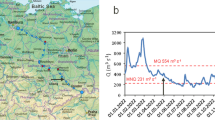Abstract
We studied the plankton dynamics in the shallow, rapidly flushed lake Neuendorfer See and an adjacent reach of the river Spree. During summer/fall, zooplankton and phytoplankton densities increased exponentially in the lake and decreased exponentially in the river without major changes in species composition. Both parts of the system can be described as tubular plug flow reactors that differ markedly in the growth rates of plankton. Whereas reproduction in rotifers was constant in the whole system, the mortality was about 10 times higher in the river compared to the lake caused by the filtration activity of abundant mussels. Physiological conditions can be regarded as continuous in the river-lake system. According to trophic conditions, the river-lake system is divided in two contrasting subsystems with the lake classified as `autotrophic' and the river as `heterotrophic' and the site of discontinuity was located sharply at the lake-river transition. At very low discharges, the differences between the subsystems were reduced and intra-pelagic mechanisms became more important. A model of plankton dynamics in the river-lake system is presented.
Similar content being viewed by others
References
Böhme, M., 1994. Release and consumption of oxygen by a phytoplankton dominated community of a eutrophic lowland river. Verh. int. Ver. Limnol. 25: 1585–1589.
Englund, V. P. M. & M. P. Heino, 1996. Valve movement of the freshwater mussel Anodonta anatina: a reciprocal transplant experiment between lake and river. Hydrobiologia 328: 49–56.
Fréchette, M., C. A. Butman & W. R. Geyer, 1989. The importance of boundary-layer flows in supplying phytoplankton to the benthic suspension feeder, Mytilus edulisL. Limnol. Oceanogr. 34: 19–26.
Idrisi, N., 1997. Impact of the zebra mussel (Dreissena polymorpha) on the pelagic lower trophic levels of Oneida Lake, NY. PhD thesis, SUNY College of Environmental Sciences and Forestry, Syracuse, NY.
Jeppesen, E., M. Sondergaard, M. Sondergaard & K. Christoffersen (eds), 1997. The Structuring Role of Submerged Makrophytes in Lakes. Ecological studies 131. Springer, New York.
Kasprzak, K., 1986. Role of Unionidae and Sphaeriidae (Mollusca, Bivalvia) in the eutrophic Lake Zbechy and its outflow. Int. Rev. ges. Hydrobiol. 71: 315–334.
Köhler, J., 1994. Origin and succession of phytoplankton in a riverlake system (Spree, Germany). Hydrobiologia 289: 73–83.
Köhler, J., 1997. Measurement of in situgrowth rates of phytoplankton under conditions of simulated turbulence. J. Plankton Res. 19: 849–862.
Lammens, E. H. H. R. & S. H. Hosper, 1998. Het voedselweb van IJsselmeer en Markermeer, trends gradiënten en stuurbaarheid. RIZA report 98.003; Lelystad: 52 pp.
Lair, N. & P. Reyes-Marchant, 1997. The potamoplankton of the Middle Loire and the role of the ‘moving littoral’ in downstream transfer of algae and rotifers. Hydrobiologia 356: 33–52.
Marzolf, G. R., 1990. Reservoirs as environments for zooplankton. In Thornton, K.W., B. L. Kimmel & F. E. Payne (eds), Reservoir Limnology. Wiley & Sons: 195–207.
Padisák, J., 1993. The influence of different disturbance frequencies on the species richness, diversity and equitability of phytoplankton in shallow lakes. Hydrobiologia 249: 135–156.
Reynolds, C. S., J. P. Descy & J. Padisák, 1994. Are phytoplankton dynamics in rivers so different from those in shallow lakes? Hydrobiologia 289: 1–7.
Riisgård, H. U., C. Jürgensen & T. Clausen, 1996. Filter-feeding ascidians (Ciona intestinalis) in a shallow cove: implications of hydrodynamics for grazing impact. J. Sea Res. 35: 293–300.
Siefert, J., 1996. Respirations-und Filtrationsraten zweier in der Spree dominierender Großmuschelarten (Anodonta anatina, Unio tumidus, Unionidae) unter Berücksichtigung der Fließgeschwindigkeit. Diploma thesis. Freie Universität Berlin: 126 pp.
Sommer, U., Z. M. Gliwicz, W. Lampert & A. Duncan, 1986. The PEG-model of seasonal succession of planktonic events in fresh waters. Arch. Hydrobiol. 106: 433–471.
Scheffer, M., 1998. Ecology of shallow lakes. Chapman & Hall.
Statzner, B., 1978. Factors that determine the benthic secondary production in two lake outflows – a cybernetical model. Verh. int. Ver. Limnol. 20: 1517–1522.
Vannote, R. L., G. W. Minshall, K. W. Cummins, J. R. Sedell & C. E. Cushing. 1980. The River Continuum Concept. Can. J. Fish. aquat. Sci. 37: 130–137.
Walz, N. & M. Welker, 1998. Plankton development in a rapidly flushed lake in the river Spree system (Neuendorfer See, Northeast Germany). J. Plankton Res. 20: 2071–2087.
Ward, J. V. & J. A. Stanford, 1995. The Serial Discontinuity Concept: extending the model to floodplain rivers. Regulated Rivers: Res. Mmt 10: 159–168.
Welker, M. & N. Walz, 1998. Can mussels control the plankton in rivers? A planktological study applying a Lagrangian sampling strategy. Limnol. Oceanogr. 43: 753–762.
Author information
Authors and Affiliations
Rights and permissions
About this article
Cite this article
Welker, M., Walz, N. Plankton dynamics in a river-lake system – on continuity and discontinuity. Hydrobiologia 408, 233–239 (1999). https://doi.org/10.1023/A:1017027723782
Issue Date:
DOI: https://doi.org/10.1023/A:1017027723782




